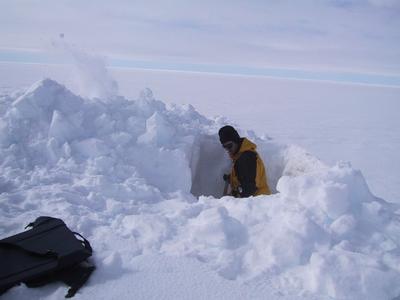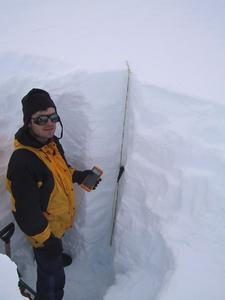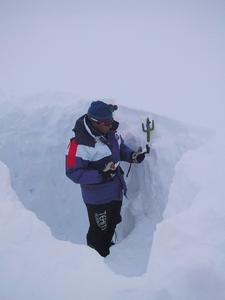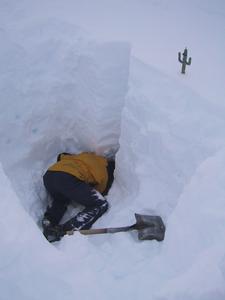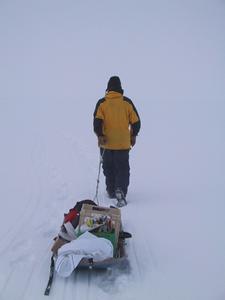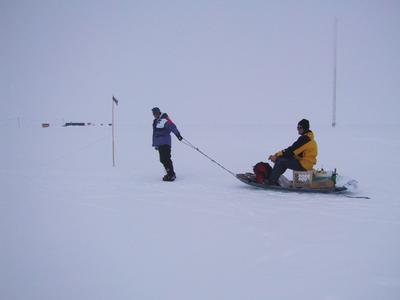
|
4 August, 2001Snow Architecture and the ice flow experiment Two meter pits. Everyone else dreads them I think they are the greatest. You get to dig yourself into this little room. The snow is solid enough that you can carve it like Styrofoam. The pallet it open ended, like clay. If you don't like your design you can cut in something new. It's like being a reverse carpenter, instead of building the house around yourself, you build into the snow, gradually expanding the space as you go. This was my second two meter pit this summer. Ever since I filled the first one back in only July 25 th I have been looking forward to digging the second one. Today's pit, about 1 kilometer from camp, included a beautiful set of stairs, a bench for sitting and a nook to put things. Of course, the real purpose of the pit was science, but why not let your imagination go wild when you are doing some pretty menial task, like digging a big hole in the snow. Like the last pit, the purpose of this pit was to sample the snow in a vertical channel. Unlike the last pit, this time I had help. Today Manuel Hutterli of the U of Az joined me. Markus, Manuel and Dee all are with the U of Az. Manuel arrived a few days ago. (Dee was here earlier in the summer) The work was fun more to share than it had been alone. I did most of the digging so that Manuel wouldn't over exert himself at high altitude, since he has only been here 3 days. Once I had designed and dug the pit, Manuel did the sampling while I handed him bottles and kept track of the data. Manuel sampled about 200 bottles. Each centimeter down the pit he took a sample. Later we will melt these bottles of snow and look for chemical elements. Manuel also measured the temperature of the snow every 5 centimeters for the first meter and then every ten centimeters the rest of the way. The temperature of the pit varies with the depth. I learned that the snow at the bottom of this pit was about -39 C. The air temperature today was about -6C. The snow is a good insulator. In the winter the snow keeps you warm because the air may be -50C and then the snow would be warmer than the air ... This is the principle of the igloo. The snow temperature effects the chemicals in the snow so Manuel and Markus want to know the temperatures at each depth. After our day of digging and sampling, I decided we needed to leave a marker in the pit in case some other innocent pit digger somehow chooses this spot to dig a pit next year ( see July 25th's entry for details of what happens when you hit an old pit or path) archeology We chose a Schott bottle, put a note in it and signed it with our names and email addresses. We definitely had a good laugh thinking of where and when this bottle might ever be found. Will it drift to the ocean in the ice as all glaciers do? Will some scientist dig it up ? in five, ten, twenty years? Will someone be out here coring and find it in their ice cores? Will this ice sheet melt and it will be come ocean water? When it is found, what will people be like? What will they think of this ancient idea of email? After a few good laughs we filled the pit back in and packed up to head home to dinner. I towed the sled of bottles and gear.... and for fun, the scientist, Manuel.
Contact the TEA in the field at . If you cannot connect through your browser, copy the TEA's e-mail address in the "To:" line of your favorite e-mail package. |




